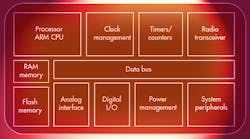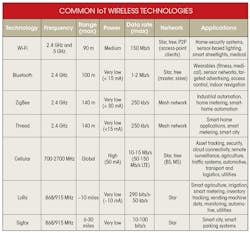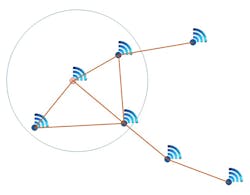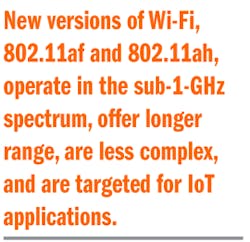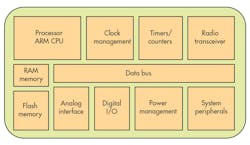This file type includes high-resolution graphics and schematics when applicable.
David Beck, VP of Marketing, Symmetry Electronics
The Internet of Things (IoT) is one the most discussed and analyzed topics in technology today. IoT is leading the development of countless new business models, inventions, services, and software. Technologies supporting the growing number of IoT applications continue to advance to keep pace with this rapidly growing market. This article provides an overview of the key wireless component technologies being used to build today's Internet of Things.
When it comes to connecting the building blocks of IoT, one size does not fit all. There are many different wireless protocols in addition to several proprietary technologies. Some applications require high amounts of data throughput, while others only send small amounts of information in short bursts of time. Products may be plugged into the wall or powered exclusively by a coin-cell-sized battery. This range of requirements makes it necessary to have multiple connectivity options to support the many possible IoT applications.
Wi-Fi
From a simplistic viewpoint, Wi-Fi is the internet. Wi-Fi is based on the TCP/IP Transmission Control Protocol/Internet Protocol which is the underlying method of routing information packets across networks. Wi-Fi, or the wireless local-area network (WLAN), was originally established as IEEE 802.11 in 1997 and quickly became adopted as the way to wirelessly connect computers and devices to the internet. Wi-Fi has evolved over time to support the growing need for higher bandwidth and more devices to connect to the internet and directly with each other.
Initially, Wi-Fi was established as a way to connect computers, laptops, and later smartphones and tablets to the internet. Its use as a data connection eventually expanded to other applications such as security cameras, data backhaul, audio, and many others. With this progression, we’ve seen two key trends emerge from Wi-Fi component suppliers: higher-data-rate devices and lower-power devices.
Wi-Fi component manufacturers continue to release new devices with faster data rates. Originally starting with 802.11b/g supporting up to a couple of megabits of actual data throughput, these devices were sufficient for most applications sending smaller amounts of information and not being used as a streaming internet connection or live web browser.
The 802.11n protocol released in 2009, six years after the 802.11g release, was a significant step for supporting a number of new applications. Key features introduced by 802.11n included increased data throughput, multiple-input multiple-output (MIMO), and support for both the 2.4- and 5-GHz frequency bands. This lead to a new generation of Wi-Fi components, with some designed to support the highest data rates possible by taking advantage of MIMO’s ability to use multiple paths to its destination. Other devices focused on the newest power efficiencies, which allowed lower-power products to transmit up to several megabits of data throughput.
The re-introduction of 5-GHz support (which was also supported by 802.11a released back in 1999) represented a significant step to providing an alternative reliable frequency band outside of the cluttered 2.4GHz band. Many of today’s Wi-Fi IoT devices are based on 802.11n.
The recent 802.11ac spec, which has once again significantly boosted the data rates achievable with Wi-Fi, is well-suited for broadband applications such as video routing and gateways. Though Wi-Fi essentially created the framework for an IoT with its multiple generations of protocols, making it possible to wirelessly connect many different types of things together and support both high and low data rates, it isn’t the best solution for all applications.
New versions of Wi-Fi, 802.11af and 802.11ah, operate in the sub-1-GHz spectrum, offer longer range, are less complex, and are targeted for IoT applications. However, these latest standards are not widely used yet.
Bluetooth
Bluetooth was developed to address two challenging areas for Wi-Fi: simple connectivity and low power. It was created as a simple cable replacement protocol and thus was intended for shorter-range communication than Wi-Fi. Today Bluetooth is also referred to as “Bluetooth Classic.” Bluetooth requires both ends to pair with each other before exchange of information. It also includes different profiles that allow the communication to be optimized for the type of information being sent.
There are two types of Bluetooth components—Class 1 and Class 2. Class 1 is designed to operate at a range up to 100 meters, whereas Class 2 is designed for up to 10 meters range. The Bluetooth standard evolved with “EDR” Extended Data Rate, which increased bandwidth from 721 kb/s to 3 Mb/s.
More recent developments with Classic Bluetooth have been extending range and data rate (24 Mb/s), as well as supporting audio. Newer Bluetooth SoCs intended to support audio include various audio codecs to make integration with different audio formats as seamless as possible. Other Bluetooth modules extend the range of Bluetooth by included a power amplifier. Now Bluetooth modules are available that specify a line-of-site range of 4000 meters.
Bluetooth 4.0, otherwise known as Bluetooth Smart or Bluetooth Low Energy (BLE), was developed as a low-power protocol for mobile devices. Although Wi-Fi continues to support lower power modes, and Bluetooth was created with even less power than Wi-Fi, Bluetooth Smart was developed from the ground up with the intention of supporting devices running on coin-cell-sized batteries. Bluetooth Smart doesn’t fully replace Bluetooth, but many of the applications originally designed with Bluetooth have migrated to the lower-power version of Bluetooth Smart. If longer range or higher data rates are needed, then Bluetooth Classic or Wi-Fi are better options.
To help with the quick adoption of Bluetooth Smart, chip manufacturers also make devices that support both Bluetooth Smart and Classic Bluetooth. These devices are called, “Bluetooth Smart Ready” or “Dual Mode.” One of the most significant developments for Bluetooth Smart came in the Bluetooth 4.2 spec, which included support for IPv4 communication. This allows a Bluetooth Smart device to directly send information to the internet, based on TCP/IP. Before this adoption, Bluetooth devices had to use a gateway or bridge to convert information to Ethernet or Wi-Fi in order to communicate to the internet.
ZigBee
1. A mesh network allows data from one mesh sensor node to pass through other nodes and extend beyond the range of the original sensor.
Prior to the release of Bluetooth Smart, ZigBee—based on IEEE 802.15.4 protocol—offered what seemed to be the ideal communication standard for IoT. ZigBee is a low-power specification that can support bursts of data transmissions of up to 250 kb/s. However, ZigBee has the advantage of supporting mesh networks, which allow devices to pass messages from one device to another, thus reaching other devices far outside the range of the original transmitter (Fig. 1). Although ZigBee captured a nice installed base in the metering market, many more products implement Bluetooth Smart or Wi-Fi instead of ZigBee as the method of communicating.
Thread
Thread is another specification based on the 802.15.4 protocol. Thread is one of the newest IoT technologies—the Thread Group formed in July 2014. According to the Thread Group website, “Thread was designed with one goal in mind: To create the very best way to connect and control products in the home.”
Thread adopted the strengths and removed the disadvantages of other IoT protocols. For example, like Wi-Fi and Bluetooth 4.2, Thread uses IP to communicate directly with the internet. However, Thread leverages a low-power version of IPv6, called 6LoWPAN, which provides each node with an IP address and a high level of interoperability. It also supports up to 250 devices in a single local mesh network.
Thread is becoming popular with IoT products in the connected home market, such as the Nest learning thermostat, and a growing echo system of sensors to connect in and around the home.
Cellular
Cellular has made important recent developments that support IoT applications. The primary advantage of cellular is that it provides a global network. Traditionally, it has focused on increasing bandwidths and coverage efficiencies to support the growing number of smartphones and tablets. For instance, 4G or LTE added a significant amount of bandwidth, increasing upload rates to 300 Mb/s and download rates to 75 Mb/s (3GPP Cat-5).
As 2G evolved to 3G and now 4G standards, M2M (machine to machine) and IoT devices saw an increase in costs for data transmission, even though most of these applications didn’t require an increase in data speeds. Both 2G and 3G cellular also required high power, a peak current of 2-A bursts for 2G GSM, which made it challenging for battery-powered mobile devices intended to last more than several days on a single charge. LTE release 8 and release 13 address these key challenges for IoT applications.
LTE Cat 1 supports download and upload rates of 10 Mb/s and 5 Mb/s versus LTE Cat-4 supporting 150-Mb/s DL and 50-Mb/s UL. LTE Cat-1 devices, which are now available, allow designs to use only one antenna instead of two.
LTE Cat-M1 represents even bigger cost-saving steps for IoT with lower data rates, lower power, simpler transmitter design, and extended range. Deployment of LTE Cat-M1 devices is expected to start in late 2017 or early 2018. Some Cat-1 modules are designed to be footprint- and software-compatible with Cat-M1. Thus, developers can start taking advantage of the new IoT adoption path taken by LTE today without having to change their designs once Cat-M1 is available.
LoRa and Sigfox
Cellular is the only IoT network that has a global reach, and is sometimes referred to as the world's most reliable network because of features such as connect and disconnect handshakes. However, even the newest cellular devices are challenged by their power budgets and infrastructure costs. These constraints have opened the door for new technologies designed to reach long distances with the lowest possible power.
Both LoRa (Long Range) and Sigfox were designed for this purpose. One of their key advantages is the cost to build a new network that covers a city-sized geographic area is much less expensive than the cost to build a cellular network. Adoption rates for LoRa have steadily grown in Europe, and the momentum is starting to build in the U.S.
LoRa presents a lower-cost network solution to countries where there isn't already a built-out cellular network. Agriculture is a market well-suited for a long-range low-power wireless technology such as LoRa. Moving forward over the next five years, its possible we'll see a combination of LoRa and cellular 4G networks making up the backbone of smart city networks.
The table above summarizes the most common wireless technologies used for IoT applications.
Summary
No single communication technology ideally suits all IoT applications. Increased range comes at the cost of higher power. Higher data rates increase protocol complexity and require more processing and memory. Applications operating on coin-cell batteries have size and power constraints, whereas other applications want as much bandwidth as possible.
2. This diagram represents a common architecture for IoT wireless systems on a chip (SoCs).
The increasing number of requirements to support the growing amount of IoT applications has led IC developers to create systems-on-a-chip (SoCs) that integrate the radio, processor, and memory, as well as support multiple wireless protocols. Fig. 2 shows the common component architecture for IoT radio components.
The first generations of radios relied on external host processors to control and drive the commands from the system. Now it’s more common for SoCs to include a dedicated processor to be used by the application itself. The computing capabilities of these processors continue to increase, and the amount of memory needed grows with the complexity.
With so many “things” getting connected to the internet, and such a wide spectrum of requirements, it's understandable why multiple IoT technologies are being used to support the rapidly growing IoT market. McKinsey projects that 20 to 30 billion devices will be connected to the internet by 2020. All of the hype about IoT is well-justified, and working with the right design partner to select the right technologies for a given application can significantly speed up the time to market for deployment.
Symmetry Electronics is an authorized global semiconductor distributor offering technical support, sales, and distribution of wireless and video technologies. It serves customers with a worldwide sales and engineering team delivering technical services alongside an e-commerce experience. Founded in 1998, Symmetry Electronics is headquartered in Los Angeles with international offices in Mexico, Brazil, Canada, and China.
